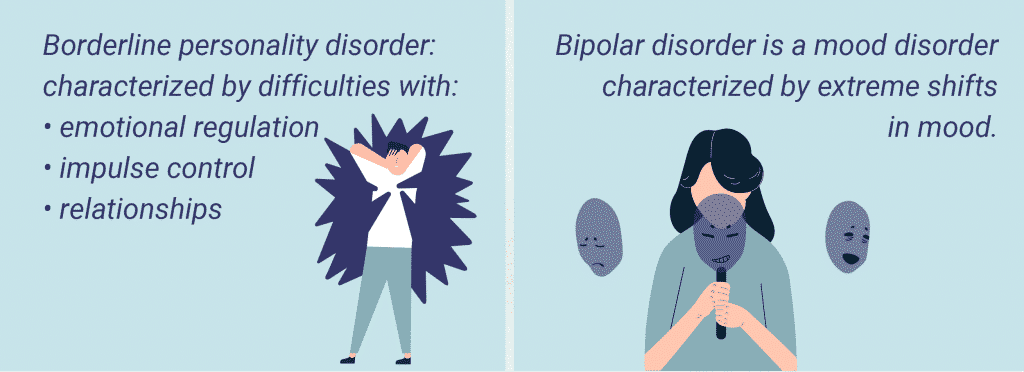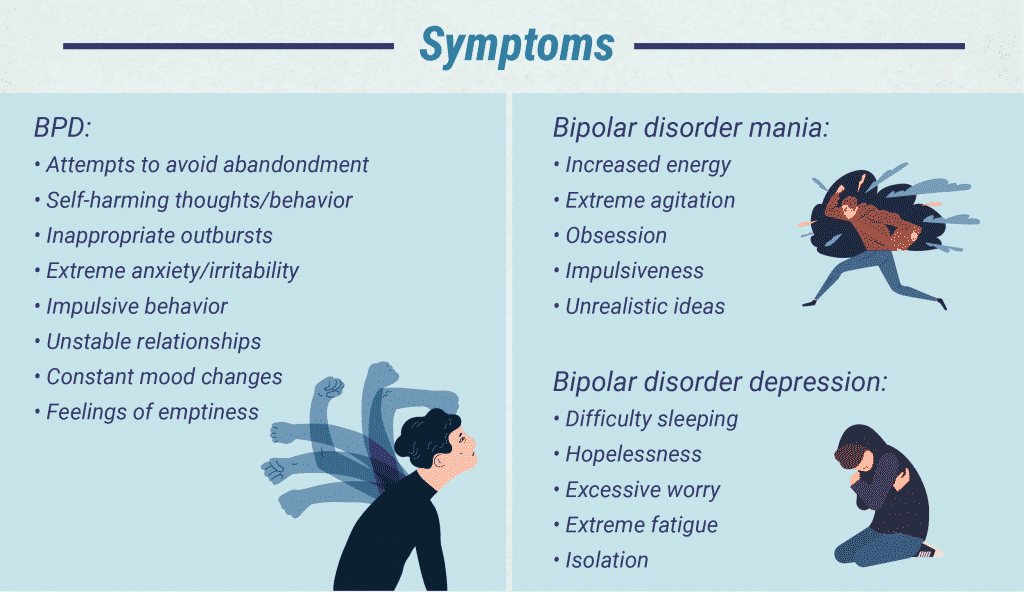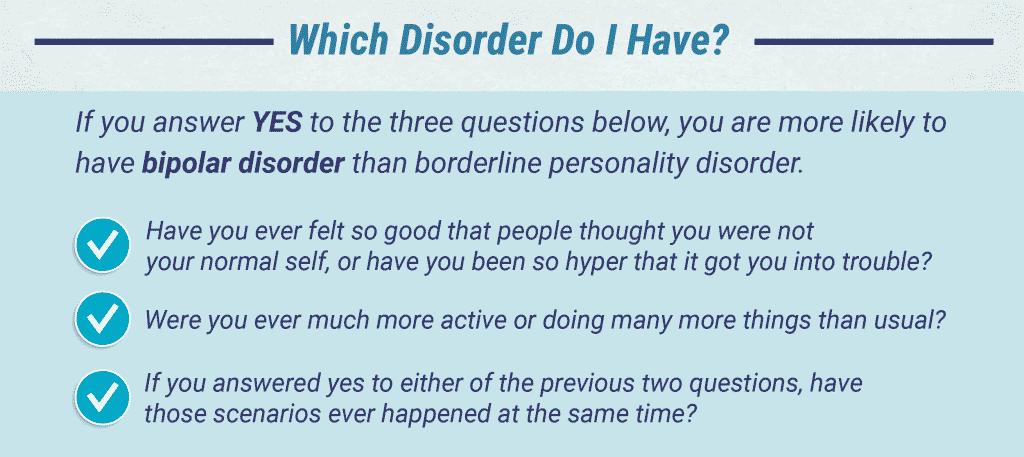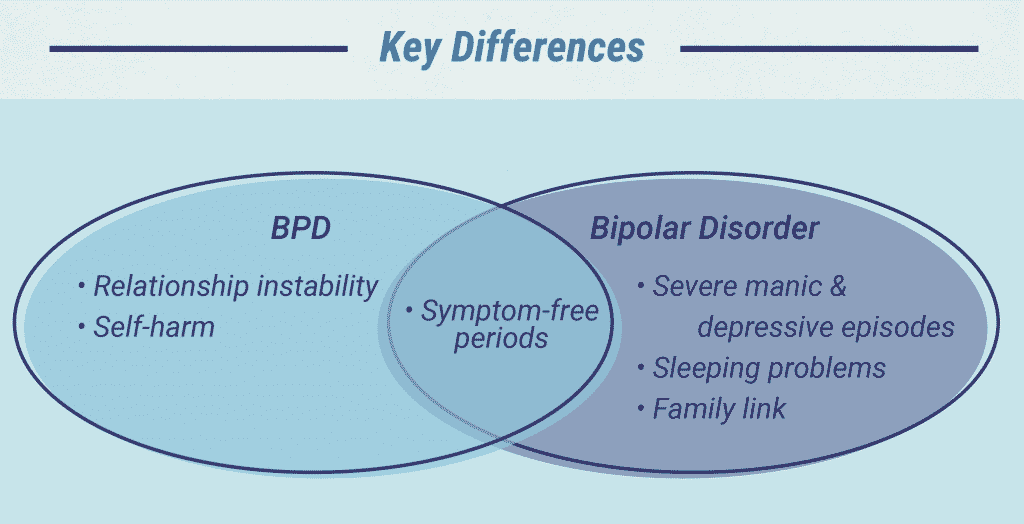Borderline personality disorder and bipolar disorder are commonly confused mental health conditions. Learn the important differences in diagnosis and treatment.
Borderline personality disorder (BPD) and bipolar disorder are commonly confused due to a few shared symptoms. However, they are very different mental health conditions that require different treatment plans. Understanding the difference between borderline personality disorder and bipolar disorder is essential for proper diagnosis and treatment.
Characteristics of Borderline Personality Disorder
Borderline personality disorder is a personality disorder characterized by difficulties with emotional regulation, impulse control, and interpersonal relationships. The lifetime prevalence of borderline personality disorder in the United States population is about 6%.
Symptoms of borderline personality disorder include:
- Desperate attempts to avoid feeling abandoned
- Unstable sense of self
- Suicidal or self-harming thoughts or behavior
- Inappropriate outbursts of anger
- Extreme anxiety or irritability
- Impulsive behavior
- Unstable relationships
- Constant mood changes
- Chronic feelings of emptiness
Life experiences, including childhood trauma, are common causes of borderline personality disorder. Neglect or abuse while growing up can lead to chronic difficulties with impulse control that characterize BPD. Overreacting to emotional situations, such as interpersonal conflicts, is a frequent sign of borderline personality disorder. The reaction may be so severe that the individual thinks about harming themselves to express their emotions and pain. Substance use disorders, such as methamphetamine addiction, are also common in those who have borderline personality disorder.

Characteristics of Bipolar Disorder
Bipolar disorder is a mood disorder characterized by extreme shifts in mood. About 3% of the U.S. population has bipolar disorder in a given year. If a person’s mood quickly shifts back and forth from a very high state (manic) to a very low (depressed) state, this may be a sign that they have bipolar disorder. During a manic state, it is common to experience racing thoughts and become overly focused on a topic. During a low state, the individual will typically become very depressed and lose interest in daily activities.
Symptoms of bipolar disorder mania include:
- Increased energy and activity
- Extreme agitation or anger
- Obsession over a subject
- Impulsiveness
- Forming unrealistic, grandiose ideas
Symptoms of bipolar disorder depression include:
- Deep sadness
- Difficulty sleeping
- Feelings of hopelessness
- Excessive worry
- Extreme fatigue
- Isolation from loved ones

Genetic factors and changes in brain structure and function are believed to cause bipolar disorder. There are two primary forms of bipolar disorder: bipolar I (bipolar one) disorder and bipolar II (bipolar two) disorder. Bipolar I disorder, also known as manic-depressive disorder, is characterized by severe manic episodes. Though not all people with bipolar I disorder have depressive episodes, many do.
During manic episodes, impulsive behavior can include excessive spending, unsafe sex or substance use. Bipolar II disorder is characterized by at least one less intense (hypomanic) episode and at least one major depressive episode. The manic periods of bipolar II are less extreme than bipolar I and may include periods of increased activity and inspiration. Symptom-free periods occur between manic episodes and can last days, weeks or even years.
Mood Disorders vs. Personality Disorders
Bipolar disorder is a mood disorder, while borderline personality disorder is a personality disorder. Personality disorders are characterized by persistent thoughts, emotions, and behaviors that deviate from the expectations of society and lead to suffering. Personality disorder symptoms typically develop by early adulthood and may be linked to childhood trauma. Symptoms of personality disorders include distrust of others, paranoia, distorted perception of reality, a poor sense of self, depression and suicidal thoughts. Personality disorders affect 10% to 13% of the general population.
Mood disorders such as bipolar disorder are characterized by severe changes in a person’s emotional state that interfere with their ability to function correctly. Mood disorders can occur at any age and may run in families. Mood disorder symptoms include depression, irritability, anxiety, loss of interest in usual activities, decreased energy or difficulty sleeping. Mood disorders affect nearly 10% of adults in the United States.
Difference in Diagnosis
A mental health professional can diagnose either bipolar disorder or borderline personality disorder by asking questions about your symptoms, collecting your personal and family medical history and using questionnaires. The mental health professional will use the 5th edition of the Diagnostic and Statistical Manual of Mental Disorders (DSM-V) to diagnose you correctly based on your symptoms.
According to The National Alliance on Mental Illness (NAMI), bipolar I is easier to differentiate from borderline personality disorder than bipolar II is. The severe manic episodes that occur in bipolar I are not seen in people with borderline personality disorder. However, since severe manic episodes are not observed in bipolar II, this type can be more challenging to differentiate from a borderline personality disorder.
Although both borderline personality disorder and bipolar disorder are characterized by emotional instability and impulsive behavior, there are several differentiating characteristics. People with bipolar disorder commonly experience switching between states of mania and depression. Between these states, they may have symptom-free phases that can last for days, weeks, months or years.
Borderline personality disorder, on the other hand, is characterized by persistent emotional difficulties and behavioral problems without symptom-free periods like bipolar disorder. Sleep difficulties are common in bipolar disorder but are seen less frequently in borderline personality disorder. Mood disorders such as bipolar disorder commonly run in families, while personality disorders are less likely to. Relationship problems, self-harm and suicidal thoughts are more widely seen in borderline personality disorder.
Studies show that people with borderline personality disorder tend to show impulsiveness and anger in reaction to relationship issues on a long-term basis. People with bipolar disorder, however, show irritability and aggressive behavior only during short-term manic episodes. Together, these unique features help mental health professionals correctly diagnose borderline personality disorder and bipolar disorder.
Is Dual Diagnosis Possible?
It is unclear whether an accurate dual diagnosis with both bipolar disorder and borderline personality disorder is possible. Some studies have shown that about 10% of people with a borderline personality disorder also have had bipolar I disorder, and 10% have bipolar II disorder. However, it is uncertain whether this dual diagnosis is a real occurrence or due to an incorrect diagnosis.
Inaccurate diagnosis can occur because symptoms change over time and overlap between the two mental health conditions. For example, temporary episodes of emotional instability associated with a borderline personality disorder might be confused with bipolar II hypomanic episodes. A thorough summary of past and present symptoms, as well as how long they last and how severe they are, will help a mental health professional correctly diagnose the two conditions.
Which Disorder Do I Have?
A recent study demonstrated that three items from a standard mood disorder screening questionnaire help differentiate borderline personality disorder vs. bipolar disorder. If you answer yes to the three questions below, you are more likely to have bipolar disorder than borderline personality disorder. Keep in mind, though, that your answers do not guarantee a diagnosis:
- Have you ever felt so good that people thought you were not your normal self, or have you been so hyper that it got you into trouble?
- Were you ever much more active or doing many more things than usual?
- If you answered yes to either of the previous two questions, have those scenarios ever happened at the same time?

Treating BPD and Bipolar Disorder
Receiving an accurate diagnosis is an essential first step in receiving the proper treatment for bipolar disorder or borderline personality disorder. Each mental health condition is treated using different methods.
Bipolar disorder treatment includes:
- Psychotherapy: working with a therapist to understand the condition and learn techniques to manage it, including cognitive behavior therapy.
- Medication: mood stabilizers, anticonvulsants, antipsychotics, antidepressants, and anti-anxiety medications
- Hospitalization: temporary inpatient treatment to stabilize and set up a treatment plan
- Group therapy: peer support groups or family sessions to help gain an understanding of the condition and learn coping strategies
Borderline personality disorder treatment includes:
- Cognitive-behavioral therapy (CBT): CBT is a form of psychotherapy that emphasizes the importance of how our thoughts and emotions affect our behavior; allows patients to learn healthy ways to deal with difficult emotions and challenging life situations.
- Dialectical behavior therapy (DBT): DBT highlights that patients can improve their response to emotional stimuli by accepting their life challenges; exercises encourage the development of skills that help the patient observe and describe their thoughts non-judgmentally
- Medications: Medications for borderline personality disorder include antidepressants and anti-anxiety medications for dealing with depression and anxiety symptoms that can accompany borderline personality disorder rather than treating BPD itself
Key Differences Between Borderline Personality and Bipolar Disorder
When it comes to differences in borderline personality disorder versus bipolar disorder, each has its own specific symptoms. These include:
- Severe manic episodes: occur in bipolar disorder but not borderline personality disorder
- Symptom-free periods: can occur in bipolar disorder between manic and depressive stages, while symptoms are persistent and long-term in borderline personality disorder
- Sleeping problems: more common in bipolar disorder
- Family link: more common in bipolar disorder
- Relationship instability: more common in borderline personality disorder
- Self-harm: more common in borderline personality disorder

If you or a loved one live with a co-occurring substance use disorder along with borderline personality disorder or bipolar disorder, The Recovery Village is here to help. Our helpful staff can guide you through the initial steps of treatment and help you find a facility nearby that works for your situation. Contact a representative today and begin the path to a healthier future.


National Institute of Mental Health. “Bipolar Disorder.” November 2017. Accessed June 10, 2019.
Ward, Randy. “Assessment and Management of Personality Disorders.” American Family Physician, October 15, 2004. Accessed June 10, 2019.
Grant, Bridget; et al. “Prevalence, correlates, disability, and […] Related Conditions.” Journal of Clinical Psychiatry, April 2008. Accessed June 10, 2019.
National Institute of Mental Health. “Any Mood Disorder.” November, 2017. Accessed June 11, 2019.
Duckworth, Ken. “Borderline Personality Disorder And Bipo[…]’s The Difference?” The National Alliance on Mental Illness, June 12, 2017. Accessed June 11, 2019.
di Giacomo, Ester; et al. “Unblending Borderline Personality and Bipolar Disorders.” Journal of Psychiatric Research, August, 2017. Accessed June 10, 2019.
Zimmerman, Mark. “The relationship between borderline pers[…]nd bipolar disorder.” Dialogues in Clinical Neuroscience, June 2013. Accessed June 11, 2019.
The Recovery Village aims to improve the quality of life for people struggling with substance use or mental health disorder with fact-based content about the nature of behavioral health conditions, treatment options and their related outcomes. We publish material that is researched, cited, edited and reviewed by licensed medical professionals. The information we provide is not intended to be a substitute for professional medical advice, diagnosis or treatment. It should not be used in place of the advice of your physician or other qualified healthcare providers.